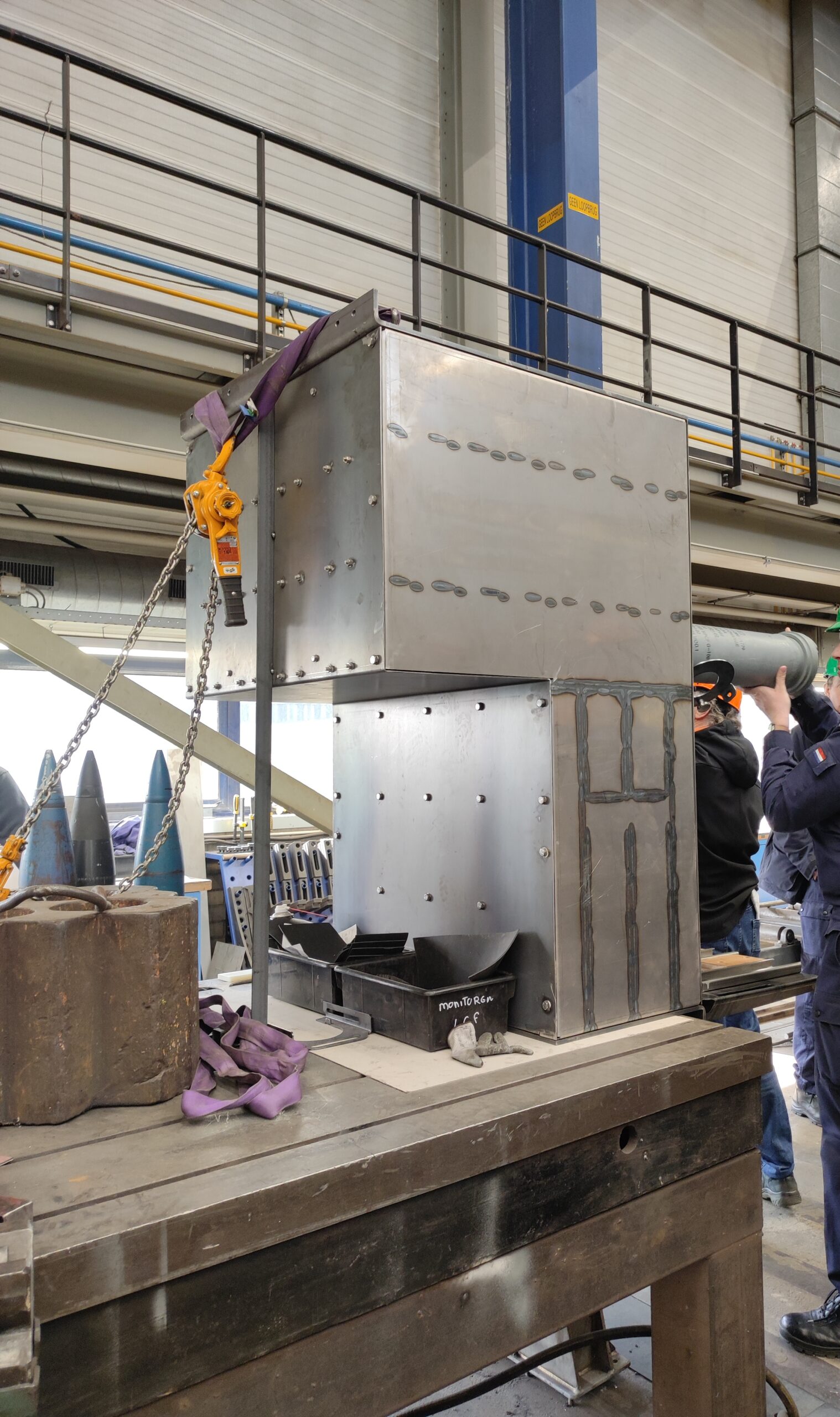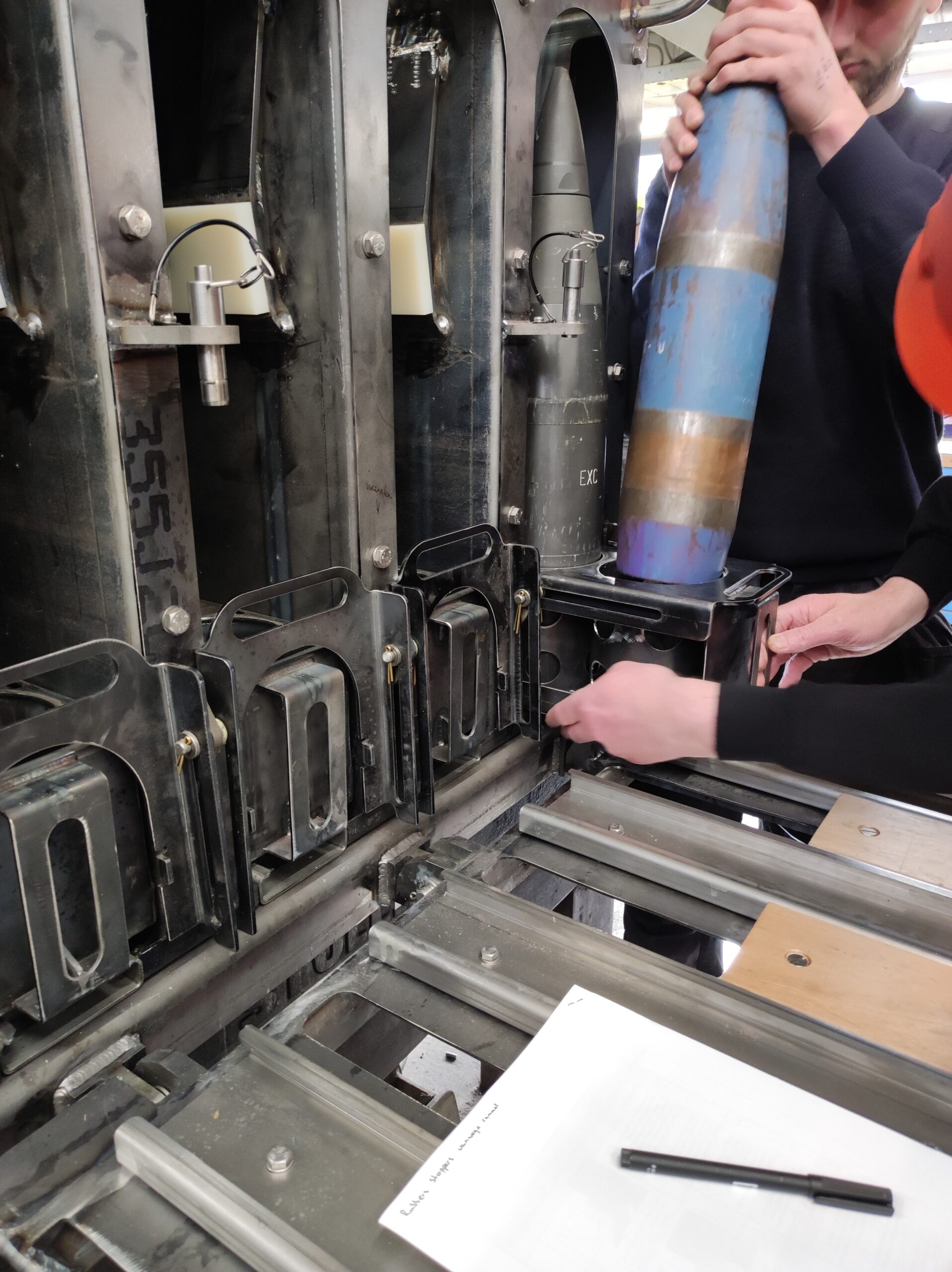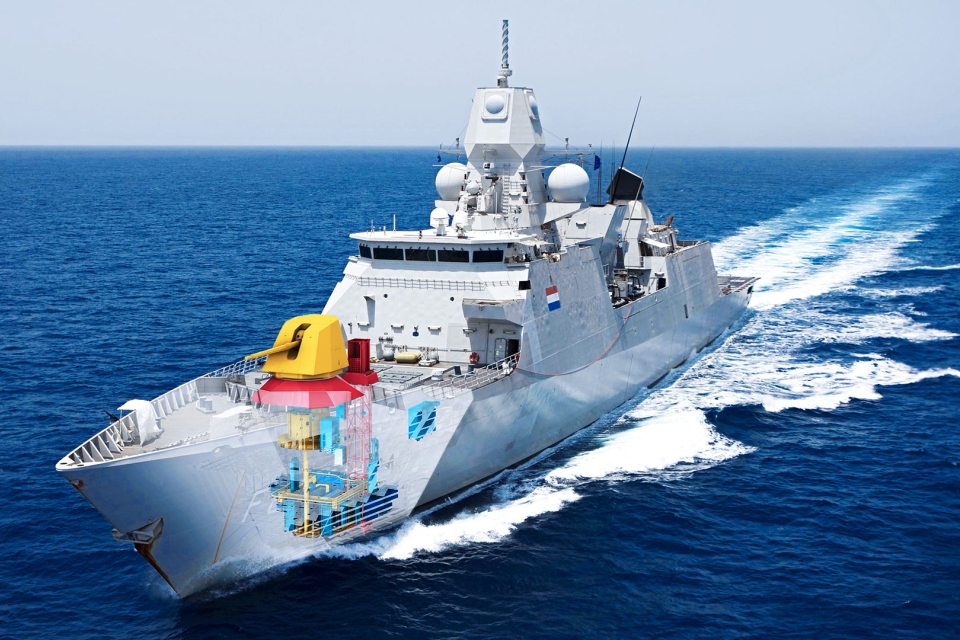After fifty years, the current main guns of the Air Defence and Command Frigates (LCFs) of the Dutch Ministry of Defence need to be replaced. This year, HNLMS Evertsen is the first of the four frigates to be equipped with a new 127-mm main gun. The Defence Materiel Organisation (DMO) calls this ‘a project of exceptional caliber’. And not without a reason. Nevesbu has been commissioned by DMO and the Italian weapon manufacturer Leonardo to perform the integration engineering and design.
This article was originally published in SWZ|Maritime’s May 2023 navy special and written by Nevesbu. Curious about the other articles in our navy special? Read the May issue online now (subscribers only). Not yet a subscriber? Become one today!
Replacing the main gun is a very complex task that requires a major redesign of the construction of the vessel. In addition to integrating a new main gun, the logistics and storage of ammunition will also be overhauled. The ammunition room will be completely redesigned, with new auxiliary equipment to ensure OHS-compliant (occupational health and safety) ammunition handling and storage.
For example, an automated ammunition handling system will allow the main gun to be loaded without the crew having to carry ammunition. Furthermore, the new storage and transport systems improve onboard health, safety and conditions, thus increasing the speed at which the main gun can be loaded.
Also read: Dutch Defence reaches agreement with Damen and Thales for ASW frigates
Tackling challenges in advance
For Nevesbu, this was a two-sided project. Commissioned by Leonardo, Nevesbu was responsible for ensuring that the main gun and all subsystems on board work as intended. In other words: designing the new layout of the ammunition room, and the new auxiliary equipment to ensure OHS-compliant ammunition handling. That was quite a puzzle. Part of it was solved by developing subsystems, such as an automated ammunition handling system, from scratch, and ensuring the integration thereof.
Commissioned by DMO, Nevesbu was responsible for ensuring that the systems supplied by Leonardo will fit on the platform: detailed and specialised system integration. This required significant engineering and redesign of the structure of the vessel, foundations of the new gun and equipment, ship systems and cabling.
The collaboration with both the client and supplier ensures any major issues and challenges on board are tackled in advance, thus relieving the Ministry of Defence of additional work thereafter. Having all the knowledge right under one roof allows to easily communicate and align with each other. Particularly in the interfaces, where the responsibilities of one party directly affect the other. This is where the greatest risks lie and is why Nevesbu was keen to represent both interests.

Starting with feasibility studies
Leonardo’s 127-mm main gun will replace the old artillery on the HNLMS Evertsen. With this type of main gun, the Ministry of Defence will be able to fire Vulcano ammunition from its LCF: much more advanced than its predecessor. Vulcano guided ammunition combines a long range with very high accuracy. It can be adjusted just before travelling towards the target.
Nevesbu was already involved in the feasibility studies at the preliminary stage of this project, in which the pros and cons of potential suppliers were mapped out. Factors considered in this phase included the ease of integration, the extent of the necessary platform adaptions and whether the designs satisfied the set (military) requirements such as shock resistance during firing. The Italian company Leonardo emerged as the winner, and turned to Nevesbu for platform knowledge and customised solutions.
System design
Nevesbu started the project with a feasibility study, in which sketch designs were made of various design solutions. These designs were then elaborated into final designs. To realise a well-functioning whole, Nevesbu used an integral project approach and specialist knowledge of the end-user use in practice to translate the client demands into specific requirements for each component. Examples of these requirements include exact dimensions, weight, consumption, space requirements for operational handling and maintenance.
When formulating the layout for the ammunition room and designing the new auxiliary equipment, Nevesbu examined how the entire logistics chain of transporting the ammunition can be conducted in compliance with occupational health and safety legislation: from the quay to the vessel’s ammunition room and from the ammunition room to the main gun, both in the port and during seaway. From this evaluation, the system requirements and (partial) solutions were further deliberated.
An important factor to keep in mind was that explosives and electricity in the vicinity of explosives can present a hazard. The use of electricity would entail many and complex requirements, which is why air pressure is used. Furthermore, compliance with the stricter occupational health and safety legislation and health and safety during the integration of all systems also had to be taken into consideration. For example, crew members on the Evertsen will soon only be permitted to lift up to 15 kilogrammes, while the ammunition weighs 32 and 18 kilogrammes, respectively.

Nevesbu has developed auxiliary systems specifically for this task to avoid adjusting the capacity: a requirement of the
Ministry of Defence. The new handling systems consist of a transport system that transfers the ammunition from the elevator to the ammunition storage room, bulk storage racks for conventional ammunition storage, and an assisted ammunition transport system that can move the ammunition within the space, for example, from the storage racks to the gun hoist.
The new layout of the ammunition room guarantees that the crew can carry out the work safely, efficiently, and according to occupational health and safety legislation, while ensuring the continuance of operations in a seaway and, for example, following a shock (an explosion in or around the vessel) or during an ambush of the vessel’s hull.
The ammunition storage is split into two parts. Part is for the old ammunition for which Nevesbu has devised a new storage system. Leonardo devised the other part to load and transport new smart Vulcano ammunition to the elevator automatically.
Platform systems integration
On behalf of DMO, Nevesbu also designed and engineered the modifications of the existing vessel, that are required to accommodate the new gun and all of its sub-systems. The steel structure, cabling, piping and support systems of the platform were severely redesigned, so that all new systems can be connected and continue to meet strict military requirements. This included, for instance, rigidity during firing, shock resistance in the event of explosions and the overall strength of the ship.
To achieve this complex task, Nevesbu applied its own systems engineering method and contributed a wealth of knowledge from various technical disciplines. Integrating the new main gun and the new auxiliary systems on board a platform with limited integration space is a complex task that involves many aspects.
Examples of challenges that reflect the complexity of this work include conceptualising the existing (minimal) space and the countless requirements regarding safety, legislation and regulations, shock resistance and efficiency. These are essential aspects to which the solution must comply. At the same time, changes in weight, heat load and power usage need to be monitored. Especially when an area is so limited, every design choice profoundly influences all the other elements. The challenge is to find an optimal balance that enables each system to function correctly and with which operations can be performed safely and efficiently at all times.
Also read: Damen upgrades Dutch Navy’s hydrographic survey vessel Snellius
Reducing 5000 kilos of weight
After the detailed design of the modifications to the vessel’s structure had been completed, the project team was asked to reduce the weight by a further 5000 kilogrammes, to create more flexibility for future modifications. Fortunately, there was sufficient remaining time for performing the necessary analyses and critical recalculations.
Complex additional strength calculations provided precise insight into the behaviour of the supporting structure during various loading conditions, such as sailing, an underwater explosion and firing ammunition. Reducing the weight by 5000 kg was quite a challenge. However, thanks to the specialists at DMO, the Royal Netherlands Navy and Nevesbu, the result is an optimised design without a single gramme of excess material.
If all goes according to plan, the main gun will be installed on board the Evertsen before the end of 2023. Following installation, its integration with all systems on board the vessel will begin. Subsequently, it will be the end of 2024 before the ship is fully equipped with a new functioning main gun and all associated subsystems. During the implementation activities, Nevesbu remains closely involved in providing on-site supervision.
Picture (top): HNLMS Evertsen showing the integration of the new main gun (all pictures by Nevesbu).
Also read: Self-creating Naval Shipbuilding under European Pressure?








